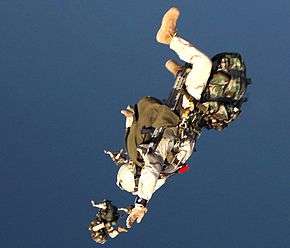304th Rescue Squadron
304th Rescue Squadron
 | |
|---|---|
|
Pararescuemen from the 304th Expeditionary Rescue Squadron free-fall during a high-altitude jump over the Gulf of Tadjoura, Africa, | |
| Active | 1957-present |
| Country |
|
| Branch |
|
| Role | Search and Rescue |
| Motto(s) | "These Things We Do, That Others May Live."[1] |
| Decorations | Air Force Outstanding Unit Award |
| Insignia | |
| 304th Rescue Squadron emblem (approved 7 October 1991)[2] |
 |
The 304th Rescue Squadron (304 RQS) is an Air Force Reserve Command combat-search-and-rescue unit located at Portland Air National Guard Base, Oregon. The squadron is a Geographically Separated Unit assigned to the 943d Rescue Group at Davis-Monthan Air Force Base, Arizona, and the 920th Rescue Wing at Patrick AFB, Florida.[1]
History
The 304th trained for combat search and rescue (CSAR) capability from its inception. The 304th was activated in the Reserves on 16 November 1957 at Portland IAP. In 1961, Pararescuemen (PJs) were added to the unit. Since then, the 304th has been training, equipping and employing Combat Rescue Officers, PJs, and support personnel worldwide in support of U.S. national security interests. It performed search, rescue, and medical evacuation missions primarily in the Northwestern United States, including over 100 missions immediately following the Mt. St. Helens volcanic eruption in May 1980. The unit responded to the crash of United Flight 173 in 1978. It maintained helicopter air refueling capability from 1985 to 1997 and deployed to provide SAR coverage worldwide, including Keflavík, Iceland, during and after the Gulf War and to the Persian Gulf region from 1990-2003. Since 2001, personnel from the 304th RQS have deployed in support of Operation Enduring Freedom and Operation Iraqi Freedom.
Operations[1]
PEACETIME The peacetime mission of the 304th is to train and maintain rescue capability for DoD personnel, humanitarian and disaster relief activities.
WARTIME The 304th's wartime mission is to provide combat rescue capabilities to recover downed aircrew members and isolated personnel. They can provide this capability under the harshest of circumstances to include, day/night, inclement weather and all terrain rescue conditions.
Lineage
- 304th Air Rescue Squadron (10/24/1957 – 1/18/1966)
- 304th Aerospace Rescue and Recovery Squadron (1/18/1966 – 4/1/1990)
- 304th Air Rescue Squadron (4/1/1990 – 2/1/1992)
- 304th Rescue Squadron (2/1/1992 – present)[2]
Assignments
- 2343d Air Reserve Flying Center (11/16/1957 – 12/1/1957)
- 2346th Air Reserve Flying Center (12/1/1957 – 4/8/1958)
- 2345th Air Reserve Flying Center (4/8/1958 – 4/8/1960)
- 4th Air Force (4/8/1960 – 9/1/1960)[2]
- 6th Air Force Reserve Region (9/1/1960 – 12/31/1969)
- Western Air Force Reserve Region (12/31/1969 – 3/15/1976)
- 403d Rescue and Weather Reconnaissance Wing (3/15/1976 – 4/8/1985)
- 939th Rescue Wing (4/8/1985 – 8/1/1992)
- 939th Operations Group (8/1/1992 – 4/1/2003)
- 920th Operations Group (4/1/2003 – 2/12/2005)
- 943d Rescue Group (2/12/2005 – present)[2]
Stations
- Portland International Airport, Oregon (11/16/1957 – present)[2]
Aircraft
- HU-16 Albatross (1958 – 1971)
- HH-34 Choctaw (1971 – 1976)
- HH-1 Iroquois (1976 – 1991)
- UH-1 Iroquois (1979 – 1987)
- HC-130 Hercules (1985–1997)
- HH-3 Sea King (1986 – 1992)
- CH-3 Sea King (1987 – 1992)
- MH-60 Black Hawk (1991 – 1992)
- UH-60 Black Hawk (1991 – 1993)
- HH-60 Pave Hawk (1992 – present)[2]
References
- Notes
Bibliography
- Cantwell, Gerald T. (1997). Citizen Airmen: a History of the Air Force Reserve, 1946-1994 (PDF). Washington, D.C.: Air Force History and Museums Program. ISBN 0-16049-269-6. Retrieved October 1, 2014.
